Commercial Ice Machine Buying Guide

Ice machines are found everywhere; from hospitality and restaurants, to healthcare facilities. While mankind prides itself in invention, we are still reliant on the natural elements. Fire creates glass, ignites our vehicles, and powers many fuels. Wind supports kites, steers boats, and spins turbines for a natural energy resource. Ice… keeps your drink cold, packs fish at the local market, and helps heal injured muscles and ease pain. These naturally occurring elements have plenty of places they will never fall out of use. But when you need ice, you need something to harvest the ice for you, but how do you select the ice machine you’ll need?
Approaching a retailer or supplier is much easier when you come with information in hand, and are not intimidated. Due to the sophistication of harvesting ice in the commercial ice making world, picking out an ice cube making machine isn’t as easy as tossing a dart or choosing by looks/aesthetics. When purchasing a commercial ice machine and ice bin, there are several factors that play a big part in your decision with the amount of ice you need for your business, the type of ice you need for your business, and where the commercial ice maker equipment is going to sit. The following guide will simplify the process for you and get you passed the technical stuff that isn’t very exciting.
1. Ice Machine Types
It is important to know that there are three main types of ice makers (keep reading to select a machine based upon ice type). Each ice maker type/configuration is catered to a specific audience. These three configurations are as follows:
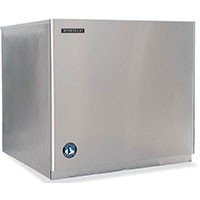
Modular commercial ice machines are designed, most commonly, for the sole purpose of creating large amounts of ice. It is important to know that modular ice machines are "modular" because they can fit on top of a variety of ice storage bins; therefore, they can be modified to suit the user's needs in ice amounts. It is necessary for the user to purchase an ice storage bin. Because of this, the purchaser may choose exactly how much ice they would like to produce, and how much ice they would like to store.
Modular ice machines are also designed with staff-use in mind. They are not designed for access by customers or the general public because reaching into a storage bin presents a potential point of contamination. Staff access the storage bin in a kitchen or behind a counter which is typical for these machines.
Modular commercial ice machines can produce between 250- 2,500 lbs of ice per 24 hrs. The ice machine bins can hold between 250 lbs of ice and up to almost 1700 lbs off the shelf; custom manufacturing for larger sizes may be an option as well.
Where modular ice machines sit? (see section 5)
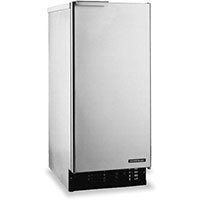
Undercounter machines are designed for both conveniences and for smaller areas that normally could not allow for an ice machine due to size/space restrictions. For example, these undercounter machines normally can be found underneath the front of a bar in order to give staff quick access to ice for customers. The most popular application for the undercounter ice machine is for home use. With their convenient size, they typically will fit under countertops that are both standard and ADA (Americans with Disabilities Act) height. These ice makers can come in a variety of cube styles.
A commercial undercounter ice maker can produce anywhere between 50 - 500 lbs of ice per 24 hrs, but undercounter home ice machines more commonly produce 100 - 250 lbs of ice per 24 hrs. Their ice cube storage amount is usually restricted by their size, typically ranging from 7 - 250 lbs of ice.
Dispenser ice machines are designed with the general public in mind. Anywhere an ice machine may be accessed by someone other than staff or employees, a dispenser is best suited. This will prevent the spread of germs or contamination from different unsupervised people reaching into an ice storage bin. A large variety of these machines dispense both water and ice. The ice being dispensed is generally in a cubelet or "chewable" form since the main application is fountain drinks and soda stations.

Not all dispensers will have a built-in commercial ice machine. When purchasing a dispenser, it's important to find this out. If the dispenser does not have a built-in ice machine, you will need to have or purchase an ice machine that will fit with it.
Dispensers can come in a variety of sizes and can produce 200 - 800 lbs of ice per 24 hrs. Due to size, they typically only store up to 250 lbs but more commonly store 8 - 12 lbs of ice at a time.
NOTE: Hotels should consider the Hotel Ice Dispenser. They will provide the same type of access (generally more sanitary due to water supply, water temperature, and water filter) as the previously mentioned ice machines. The only difference is they produce much higher volumes of ice. These commercial hotel ice machines can on average produce up to 500 lbs of ice per 24 hr period; and can hold up to 200 lbs of ice at a time.
2. What Type of Ice do You Need?
With the vast amount of ice cube styles available, it’s easy to fall under the trap of selecting a cube style by visual appeal. However, these different cubes are designed for very specific purposes. These purposes are designed to help you, the ice cube harvester, keep your customers happy and save you time and money. The following are the main styles of cubes, with their intended purpose.
| Cube Image | Cube Style | Melting Rate | Intended Purpose |
 | Crescent Cube (common ice) | Medium. Will not melt too fast therefore will not dilute drinks. | Probably the most popular of cube styles. They are found in every type of location due to their “all around” performance. Restaurants, hotels, bars, convenience stores, and hospitality. |
 | Flake Ice (packing ice) | Melts very fast. Less dense ice. Oversize a flaker ice machine, because you’ll be using more ice. | Great for healthcare purposes due to their ability to “pack” and “bend.” Also, this style is the preferred style for packing fish and other food items. |
 | Cubelet (chewable ice) | Similar to the Flake ice in that it’s less dense than other ices. Melts quicker than cubed, but not as quick as flaked ice. Think of it as Flake Ice with style. | Good enough for restaurants, better fit for concessions, bars, convenience stores, and hospitality. This is also the cube for ice chewers. Being less dense and with its small shape, this is quite appealing. |
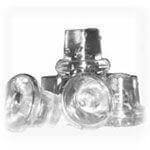 | Top Hat (designer ice) | Medium. Melts slower than Crescent Cube. | These are more of a designer cube. They are best placed in executive suites, offices, or homes. |
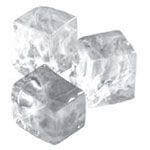 | Square Cube (bar ice) | Slowest to melt of them all. | Alcohol and spirits; this is the slowest melting ice so it will not dilute the drinks. They are best for bourbon based drinks. Their shape creates fluid displacement; meaning, less money will be spent by the bar on pouring alcohol. |
3. How Much Ice Do You Need?
This isn’t an easy question to answer. Larger restaurant chains have the ability to ask corporate exactly what the area needs for ice consumption or even an exact model of commercial ice maker machine they need. But if you don't work for a corporate food chain, you need to finish reading this guide. Fortunately, some like-minded people got together and came up with a few formulas that will take care of almost any ice application.
To simplify it further, I just pushed all of those formulas into a nice little chart. All you have to do is find your business niche and follow the formula.
| Ice Usage | Ice Needed |
| Convenience Store | |
| Beverages: | 5oz. per 7-12 oz. cup 8oz. per 12-16 oz. cup 12oz. per 16-24 oz. cup |
| Cold Plates: | 45% more per day, than what is calculated by beverages. |
| Packaged Ice: | 10 lbs per bag times bags sold per day |
| Food Service | |
| Restaurant: | 2 lbs. per person |
| Cocktails: | 3 lbs. per seat |
| Water Glass: | 4 oz. per 10 oz. glass |
| Salad Bar: | 30 lbs. per cubic foot |
| Quick Service: | 5 oz. per 7-12 oz. cup 8 oz. per 12-16 oz. cup 12 oz. per 16-24 oz. cup |
| Flaked Ice: | 2 pounds of flaked ice per person served. |
| Healthcare | |
| Patients: | 10 lbs. per bed |
| Cafeteria : | 1.0 lbs. per person |
| Lodging | |
| Guest Ice: | 5 lbs. per room |
| Catering: | 1.5 lbs. per person |
| Schools | |
| Cafeteria: | 1.5 lbs. per student |
| Flaked Ice: | 2 lbs. per person |
| Supermarket | |
| Cubed Ice: | 32 lbs. of ice per cubic foot to fill |
| Flaked Ice: | 27 lbs. of ice per cubic foot to fill |
| Office | |
| Cubed Ice: | 1.5 lbs. per Employee |
| Flaked Ice: | 2 pounds of flaked ice per Employee. |
| Cubelet Ice: | 2 pounds of flaked ice per Employee. |
(note: OVERSIZE YOUR MACHINE - Once you have the amount of ice production you need, oversize your ice machine by one size. This will account for busy weekends, expansion, etc.; and they won’t overproduce because they can be shut off (most of them automatically once a height had been reached). The other frugal method of farming your own ice would be storing some in the walk-in freezer for the busier days.
4. A question about compressors…
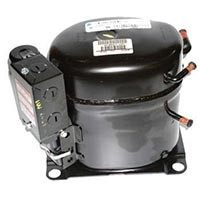
The location of your commercial ice machine equipment is a little easier to overlook when selecting an ice machine, especially if you need a smaller sized ice machine. If you are placing your ice machine undercounter, then the type of ice machine is already selected for you. However, if you are running a hotel and will be placing the ice machine in a tight spot with no breathing room, you will need a way for the compressor on the machine to breathe. Let’s turn that around and say it differently, then list it out.
An ice machine with an air compressor is going to need to suck in and blow out the air. Otherwise the machine would not produce consistent ice, or the compressor on the machine could potentially be damaged. An ice machine with a remote compressor, has an air condenser somewhere, such as on a roof, connected to the ice machine by a line. Lastly, an ice machine with a water cooled compressor can go anywhere with an extra water supply line.
It's also important to think about noise. Compressors can be quite noisy, especially if you’re the guest of a hotel and happen to have the room right beside the ice machine.
| Compressor Type | Noise Level | Pricing | What's Needed |
High | The lowest priced ice machine are the air cooled compressor type. | These machines need room to breathe, else they will not function consistently and could potentially get damaged. | |
Low - Medium | They are priced higher than air cooled models, however, there isn’t much of a marginal difference. Consider your water bill. | In order to run a water cooled ice machine, you need 2 water lines. One line for your ice, and one line for your compressor. Because they require a water line instead of breathing room, they can fit in the tightest spots. | |
Most all of the noise is taken elsewhere, noise level by the machine is minimal. | They are priced considerably more than either of the other cooling types. However, in the long run they pay off because they will produce more consistent ice and there is no water bill associated with it like the water cooled type. | Remote condensers are, more times than not, not sold with the ice machine. They are usually a separate purchase and also require a line set that connects the condenser to the machine. You also need a place to put it. They belong outside and have to be placed on a concrete slab (are usually placed on roofs). |
5. Storage & Dispensers
Ice Machine Bins
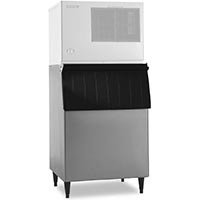
Modular ice machines are considered modular because they will fit on a variety of storage bins, you can upsize and downsize these bins as you please. And therefore most ice machine brands will manufacture bins in many sizes; typically ice machine bins that store between 250 lbs to 1650 lbs of ice at a time. Other than storage capacity, bins will also come in a variety of widths in order to match corresponding ice machine models (i.e. 30” bins will typically hold a 30” ice machine or smaller). But other than making sure you can store ice and hold the ice machine, what else do you need to know?
Upsize: Make sure to upsize. An industrial ice machine and bin combo can be adjusted after installation, to only dispense a limited amount of ice. However, storing ice is a great advantage to have whether it’s for the purpose of packing fish/meats or filling soft drink cups.
Also, consider that some business hours may call for more ice than others. Because it can be difficult to come to an exact measurement of how much ice you may need at a specific time through the business week, upsizing can provide a little relief. During downtime, ice can be stored in a freezer and then used during those busy hours.
Downsizing: Some commercial ice machines will be wider or deeper than the bin you may have selected. You will want to make sure that this isn’t the case because, while this may not hurt the dispensing of the ice from the machine into the bin, it could very well affect the integrity of the ice machine structure, thus it may not last as long as it should.
Top Kits: What if the ice machine you chose is smaller in width or depth than the bin you chose? Make sure to purchase a topkit if you are purchasing an ice machine/bin combo that falls under this situation. If you are purchasing a bin that is a different brand than your modular ice machine, then the top kit will have to come from the bin manufacturer. In either instance, talk to your sales representative to get the right information on the topkit you need.
Ice Dispensers
Purpose: Dispensers are designed to give people access to ice, in a sanitary way. Unlike bins, which require the user to reach in where the ice is being stored; dispensers prevent cross-contamination by not allowing access to the ice storage by unmonitored persons.
Dispensers are available in different capacities that are usually restricted to the dispenser type. For example; countertop units have (typically) very small storage capacity whereas hotel dispensers can hold up to several hundred pounds of ice at a time.
Self Contained vs Manual Load vs Modular:

Self Contained dispensers are designed with a built-in ice machine. Because of this, they may cost more to operate over time, but since they produce their own ice, they may pay for their initial cost very quickly with performance.
Also, self-contained units do help keep things simple since you don't have to worry about pairing the correct ice bin with the ice machine and you don't have to worry about manually filling up the ice dispenser so it has ice to serve to your customers or crew members.
With that said, generally, self-contained ice makers don't produce as much ice as a modular ice machine. So this is definitely a factor to keep in mind.
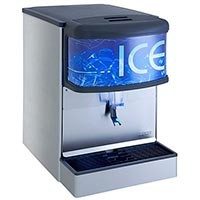
Manual Load ice dispensers are exactly how they sound. They will take care of the ice dispensing, but the staff is responsible for filling it with ice. They are best used where an ice machine and bin are currently on location which is only accessible by staff. Despite the threat of more manual labor, this is an excellent option when excess ice from an ice machine is stored in a freezer in order to supply the dispenser when necessary.
An additional thing to know about manual fill units is that there are extra sanitation factors at play. Since your crew will have to use an ice bucket to transport the ice from a modular ice machine to the manual fill dispenser, you are making room for bacteria, viruses, etc to be added to your ice, during the process. The reason for this is, have you ever seen where the ice buckets are stored or how the person transporting the ice, handles the bucket? You'll notice that in many cases, the ice bucket is kept in a dirty area, rarely cleaned, and/or the transporter doesn't clean their hands. This is very unsanitary and definitely needs to be kept in mind, if you care about other's health.
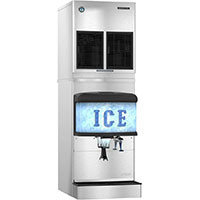
Modular ice & water dispensers generally refer to dispensers that require there to be an "ice machine head" or "modular ice maker" placed on or mounted to it. Keep in mind however that just because it says modular, does not mean that these units can be manually filled. There are going to be some modular ice dispensers that will allow them to be manually filled by a human but it's always best to ensure you do your due diligence in choosing the correct model ahead of time. Call us and we'll be happy to determined which model you need for your current application.
Storage for all of these units are very small in comparison to ice storage bins and hotel dispensers. However, this is because they are designed to drop small amounts of ice per serving, whereas its counterparts (bins and hotel dispensers) are both designed to allow large quantities of ice to be taken from the unit at a time. Because of this reason, they are very efficient for their purpose.
Hotel Ice Dispensers
Hotel Ice Dispensers are (as mentioned before) designed to dispense large amounts of ice at a time. Because of this, they can generally hold a much larger ice machine than manual load (or non-self-contained) ice machines.
note: hotel ice dispensers are almost always not self contained, therefore always size an appropriate ice machine to make the ice for the dispenser.
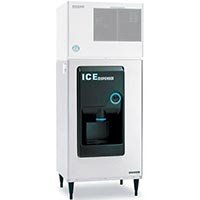
Also, due to their size, they require dedicated floor space. These dispensers are generally kept in a separate room or in a nook in a hallway. When deciding where to place one of these dispensers, bare in mind that since it carries large ice machines, it will produce more sound… not very pleasant for a guest who may be sleeping on the other side of the wall.
Think outside the box… These dispensers are intended on serving large amounts of rooms; and due to their capacity, some businesses have found the use of:
- filling large amounts of ice buckets for employees or with these dispensers
- storing large amounts of ice for packing produce
Note on Sizing: Just like sizing an ice machine/bin combo, making sure the ice machine isn’t too large for the dispenser that is carrying it, and may require a topkit in order to properly mount an ice machine (see above topkit section).
Ice Baggers

Ice baggers may be the option of an ice dispenser that you may want to consider. Their primary role is to dispense large amounts of ice into different size bags in a more sanitary way than an ice bin can. Bagger Dispensers are designed to accommodate a Modular Ice Machine (generally attached on top of the dispenser), and because of this, they can produce whatever type of ice that the modular machine produces.
Think Outside the Bag:The typical application for an Ice Bagger is for dispensing ice into a bag, to be sold as product. And while they work wonderfully for this, they can be used for much more. Some companies have found that bagging ice can be an efficient way to store or transport ice; while other companies have found that filling ice buckets/boxes instead of bags of ice is an efficient and clean way to provide employees with “job-site ice.”
Note on Sizing: It’s important to know that since ice baggers rely on the modular machine to make the ice for the dispenser, sizing the right amount of ice will be dependent on the Modular Ice Machine. Most importantly, you will want to make sure that the dispenser can dispense as much ice as the Modular Ice Machine that you select.
You’ll also want to make room. For the same reason that you wouldn’t want to crowd a Hotel Dispenser (noise level, floor space, and heat), you’ll want to make sure that a Bagger Dispenser is in an accessible space for the users but is also in an uncrowded dedicated space.
6. Preventive Maintenance

The one thing that you can do in order to care for your ice machine, no matter the type or location, is make sure that it is only using clean water. Just like humans: the cleaner the water, the healthier the machine. Not only does using a water filter prevent scale and lime buildup to maintain optimal water flow and freeze cycle, but it also relieves the water of chloramine. Removing the chloramine means removing the awful effects (see here), taste and lessen service calls. It could also extend the life of your machine. Water filtration systems should always be the first form of defense and care when it comes to your ice machine.
You can read further about selecting the proper water filtration here.
7. Putting It All Together

Don't take off just yet... When purchasing an ice machine that will sit on a bin or dispenser, always check to see if a topkit or converter kit is needed. Some bins or dispensers may be wider than the ice machine you place on them. This means that the ice machines won't completely close the opening where they sit. In order to close the gap, there are conversion kits or topkits available. Not covering up the gap between the machine and bin/dispenser means a possible health code violation. Ask your customer service representative for the right topkit when ordering an ice machine with or for a bin/dispenser.
It may take a few minutes or a few months to plan your total ice harvesting at your business. But with the right information, an accurate selection for what you truly need in order to run your business smoothly and economically, is possible. By compiling these facts together, selecting an ice machine will be a much more profitable experience for both you and your customers.

(while you're at it, check out our harder than ice infographic)
Share This!